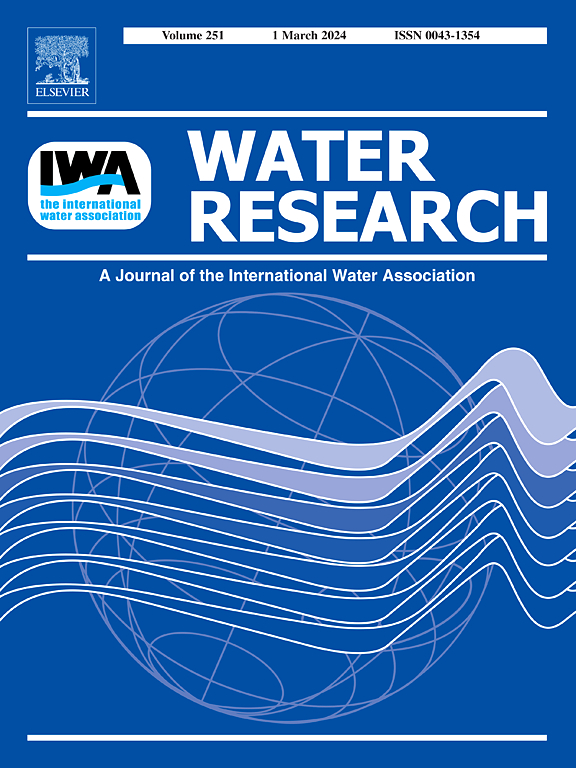Integrated wide-scope and class-specific nontarget analysis reveals a broad spectrum of organic micropollutants in an urban river
IF 12.4
1区 环境科学与生态学
Q1 ENGINEERING, ENVIRONMENTAL
引用次数: 0
Abstract
Environmental monitoring using nontarget analysis (NTA) has become a powerful tool for identifying complex mixtures of organic micropollutants in aquatic systems. Herein, we developed an integrated screening strategy that combines wide-scope NTA with class-specific NTA to comprehensively characterize micropollutant occurrence in the Chaobai River, Beijing, with a watershed that features a variety of human impacts and land cover patterns. In addition to the 293 micropollutants identified through target analysis and wide-scope NTA, class-specific NTA revealed 161 additional nontarget chemicals, including 28 per- and polyfluoroalkyl substances, 50 organophosphate esters, and 83 antibiotics and their transformation products, significantly expanding the chemical space identified by traditional wide-scope NTA. Concentrations of the 454 micropollutants spanned over five orders of magnitudes, with 27 exceeding 100 ng/L (median concentration) and 23 detected in over 90 % of samples. Spatiotemporal analysis revealed four distinct micropollutant distribution patterns, with two sample groups exhibiting significantly different profiles. The lower river, influenced by reclaimed water, showed higher concentrations and more frequent detections of wastewater-derived micropollutants, whereas the upper river and reservoirs were dominated by agriculture-related micropollutants. Key micropollutants and water quality parameters were identified as robust indicators for tracking occurrence patterns. This integrated screening strategy enables the detection of a broader spectrum of chemicals and provides deeper insights into their distribution, offering a transformative and expandable framework for future environmental monitoring and risk assessment.


综合大范围和类别特异性非目标分析揭示了城市河流中有机微污染物的广谱
利用非目标分析(NTA)进行环境监测已成为识别水生系统中复杂的有机微污染物混合物的有力工具。在此,我们开发了一种综合筛选策略,将大范围NTA与特定类别NTA相结合,以全面表征具有多种人类影响和土地覆盖模式的北京潮白河流域的微污染物发生情况。除了通过目标分析和大范围NTA鉴定的293种微污染物外,类别特异性NTA还发现了161种非目标化学物质,包括28种全氟和多氟烷基物质,50种有机磷酸酯和83种抗生素及其转化产物,大大扩大了传统大范围NTA鉴定的化学空间。454种微污染物的浓度跨越了五个数量级,其中27种超过100纳克/升(中位浓度),23种在90%以上的样品中检测到。时空分析显示了四种不同的微污染物分布模式,两个样本组表现出显著不同的分布特征。下游河流受再生水的影响,废水微污染物浓度更高,检测频率更高,而上游河流和水库主要是与农业有关的微污染物。关键微污染物和水质参数被确定为跟踪发生模式的稳健指标。这种综合筛选策略能够检测更广泛的化学品,并对其分布提供更深入的了解,为未来的环境监测和风险评估提供了一个变革性和可扩展的框架。
本文章由计算机程序翻译,如有差异,请以英文原文为准。
求助全文
约1分钟内获得全文
求助全文
来源期刊

Water Research
环境科学-工程:环境
CiteScore
20.80
自引率
9.40%
发文量
1307
审稿时长
38 days
期刊介绍:
Water Research, along with its open access companion journal Water Research X, serves as a platform for publishing original research papers covering various aspects of the science and technology related to the anthropogenic water cycle, water quality, and its management worldwide. The audience targeted by the journal comprises biologists, chemical engineers, chemists, civil engineers, environmental engineers, limnologists, and microbiologists. The scope of the journal include:
•Treatment processes for water and wastewaters (municipal, agricultural, industrial, and on-site treatment), including resource recovery and residuals management;
•Urban hydrology including sewer systems, stormwater management, and green infrastructure;
•Drinking water treatment and distribution;
•Potable and non-potable water reuse;
•Sanitation, public health, and risk assessment;
•Anaerobic digestion, solid and hazardous waste management, including source characterization and the effects and control of leachates and gaseous emissions;
•Contaminants (chemical, microbial, anthropogenic particles such as nanoparticles or microplastics) and related water quality sensing, monitoring, fate, and assessment;
•Anthropogenic impacts on inland, tidal, coastal and urban waters, focusing on surface and ground waters, and point and non-point sources of pollution;
•Environmental restoration, linked to surface water, groundwater and groundwater remediation;
•Analysis of the interfaces between sediments and water, and between water and atmosphere, focusing specifically on anthropogenic impacts;
•Mathematical modelling, systems analysis, machine learning, and beneficial use of big data related to the anthropogenic water cycle;
•Socio-economic, policy, and regulations studies.
 求助内容:
求助内容: 应助结果提醒方式:
应助结果提醒方式:


